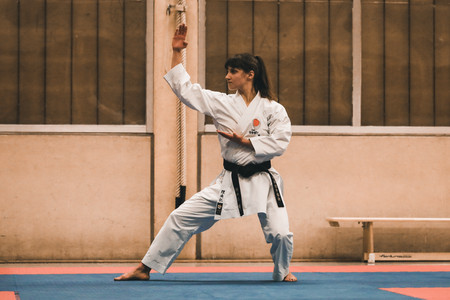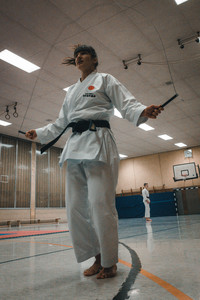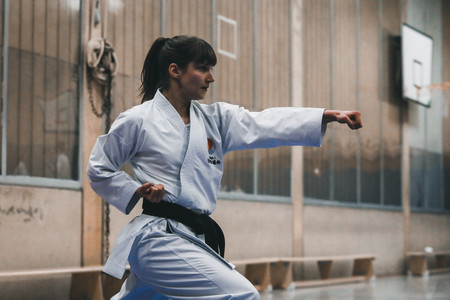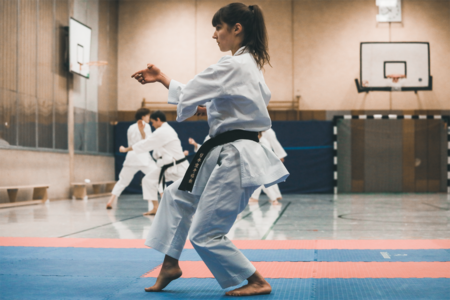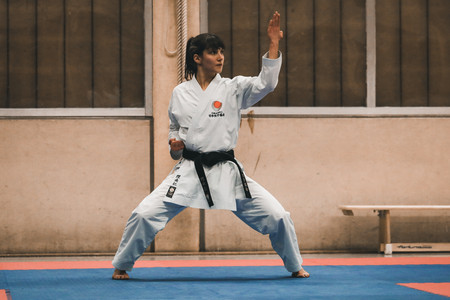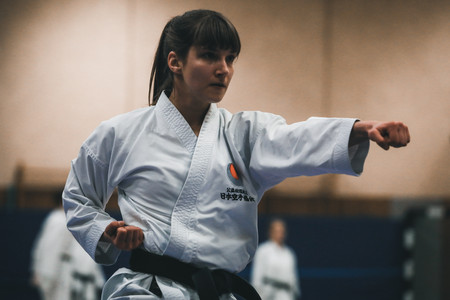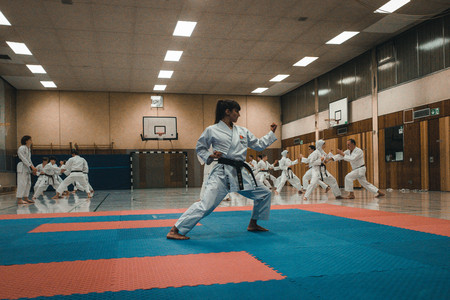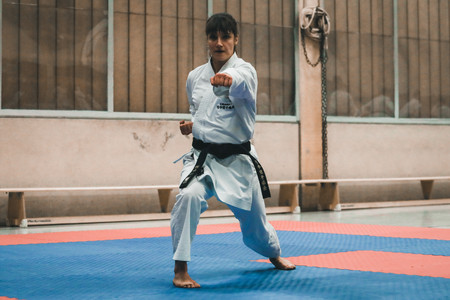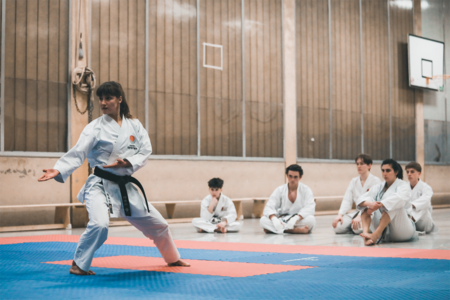As a competitive athlete, Leonie Diffené not only manages the balancing act between her professional and training life but also excels in both areas. Alongside her research in the field of demography and social inequality, she held her own at the World Championships last October. Leonie Diffené and her team won the runner-up world championship title in the “kata” category against many competitors.
To put this success into perspective, it helps to look back on history: The roots of karate – translated as “empty hand” – lie in Okinawa, a Japanese prefecture consisting of over 150 individual islands in the East China Sea. As the centre of the independent island kingdom of Ryukyu, Okinawa maintained lively trade contacts with China as early as the 14th century. This brought the first influences of the Chinese martial art of kung fu to the islands. Over time, these influences were developed by the Ryūkyūjin into their own techniques and styles.
Due to its economic importance, Okinawa was long the scene of unrest and uprisings, which led to a ban on weapons in 1422. This ban was tightened after the annexation of the kingdom by Japan in 1609, as a result of which the inhabitants of Okinawa concentrated on unarmed defence. To prepare for possible attacks, the inhabitants trained in unarmed hand-to-hand combat. Conflict meant that writing down techniques and tactics was tricky, as everything could fall into enemy hands or be lost. The inhabitants therefore recorded their techniques and exercises in choreographed sequences of movements, known as “kata” (literally “a series of defined movements”).
At the beginning of the 19th century, several Okinawan masters popularised their martial art in Japan. Gichin Funakoshi then made a significant contribution to establishing karate as a sporting discipline by promoting the standardisation and systematisation of the rules. After the Second World War, karate continued to spread as a sport until it became an official discipline in international sports federations in 1964. This was followed by the formation of international karate associations such as the World Karate Federation (WKF) and the Japan Karate Association (JKA). In 2020, the International Olympic Committee included karate in the programme of the Olympic Games in Tokyo.
Today’s karate is based on three pillars: kihon (“basic school”; techniques and technique training), kata (choreographed movement sequences without an opponent) and kumite (fighting with an opponent). Kata and kumite are practised in the form of competitions at tournaments.
Leonie Diffené is at home in kata. Born in Magdeburg, she began her sporting career as a child with gymnastics, but at the age of six she wanted to try something new. Her mum asked around and found karate. “My mum still tells me today that my eyes always lit up when I went to karate,” says the 27-year-old.
Diffené trained at her home club until she graduated from high school and became European junior kata champion. She remained loyal to karate throughout. She also played football for a while but chose to continue with karate due to the extra commitment.
Every karateka is trained in all three basic areas at the beginning. Only later does a specialisation in kata or kumite follow. Diffené decided in favour of kata, as she progressed more quickly and enjoyed kata more as a discipline. We visited Leonie Diffené during a training session.
Monday evening, it’s raining outside. We enter a dull green and brown multi-purpose hall in Troisdorf. Hardly anyone would guess that this hall is the forge of a reigning world championship runner-up.
Leonie Diffené is first in the hall, warming up with a skipping rope before other karateka gradually arrive. The first of them to arrive is Stefan Gerdesmeyer, coach of the Karate Dojo Ochi Troisdorf club. The atmosphere is upbeat; first he chats with Diffené about her competition last weekend. Then, together with other trainees, they set about bringing some colour into the hall and lay bright red and blue mats on the hard hall floor. While everyone is busy puzzling the individual mats into a 10 x 10 metre square, Diffené tells me: “These are the mats that I also compete on. I train kata on the mats here, while everyone else trains kumite over there.”
Once all the mats have been laid out, Diffené begins her training on her own while everyone else trains with a partner in the other half of the hall. She repeatedly goes through individual movements and then individual sequences of her competition kata.
The kata she is practising for the final rounds is called Gojushiho Dai, which translates as “54 steps”. In this unit, Diffené definitely takes more than 54 steps. She goes through the same movements over and over again, almost mechanically.
Alongside her club colleagues, who keep trading blows, the untrained eye might get the impression that kata is “not really fighting at all” – a persistent preconception. After all, you may not be fighting a physical opponent in a kata, but you are always fighting with yourself. “You strive for perfection, even though you know you’ll never achieve it. But striving for constant improvement also drives you on. I’m then in the flow. I forget everything around me. There’s nothing better than training for two hours and not thinking about anything else during that time,” summarises Leonie Diffené.
Her determined pursuit of perfection will pay off in October 2024, when Diffené and two teammates win the runner-up world title for Germany. The kata discipline exists not only as an individual category, but also as a team category. Three members of each team stand together on the mat and try to present the same kata as synchronised as possible.
As the last world championship was held seven years ago due to the pandemic, the upcoming championship was eagerly awaited. “The preparation for this event was really enormous and the three of us really grew together as a team once again,” says Leonie Diffené. In the end, they were able to secure the silver medal behind the Japanese. An outstanding success, as Leonie Diffené’s assessment makes clear: “The Japanese always win and it’s almost a sensation when they do lose. That’s why second place feels like first place – if you exclude Japan.”
The competition hall in Takasaki, just under three hours north-east of Tokyo, was not an unknown variable for Diffené on her competition day. She had already been able to familiarise herself with the local conditions during two visits to Japan in the last two years and train with her Japanese colleagues and role models. “You always orientate yourself on the karate of the Japanese. I’ve always watched videos of past and current world champions on YouTube. And then I was able to train with them. It was a little dream come true,” she beams.
The flexibility that Diffené has in her doctorate has also contributed to the fulfilment of this dream. After graduating from high school, it was clear to her that Cologne was an ideal location for her sporting career due to its proximity to the renowned club in Troisdorf. She also recognised WiSo as a leader in the field of sociology right from the start and therefore also appreciated the quality of the education she would receive here.
After her bachelor’s degree in social sciences, she completed a double master’s degree in demography and social inequality, then worked in Professor Leopold’s department and conducted research in his KINMATRIX project on family-related data from Europe and the USA. Through her work, she quickly found herself in contact with doctoral students and was able to get an idea of whether a doctorate would suit her. Thanks to the excellent academic supervision and colleagues who supported her in her sporting endeavours, she ultimately decided in favour of a doctorate at WiSo.
In addition, the scholarship from the Cologne Graduate School offers her the flexibility she needs to successfully combine her academic and sporting ambitions. As part of her doctorate, she is researching family networks and relationships, particularly those of people with a migration background. In the summer, she will then spend four months at the University of Tokyo researching attitudes towards immigration and comparing the European and Japanese contexts. Of course, she will also use this research stay to train diligently in karate in Japan.
Leonie Diffené not only logistically links her professional career with her sporting career. She also finds structural overlaps between her doctorate and karate. In both areas, she is deeply involved with a specific topic, remains persistent, meticulous and invests a lot of time. And the pursuit of perfection is often a constant companion. Another aspect is constant learning. Diffené says: “The more you learn, the more you also learn what you can’t do. But that’s also the beauty. It never ends.”
Another advantage of continuous learning is that it constantly opens up new goals – and Diffené currently has plenty of them. In addition to completing her doctorate, hopefully followed by a post-doc in the field of migration, she will soon be competing in the German and European Championships. The goal is clear: to reach the podium, both individually and with her team.
Leonie Diffené also sees herself connected to her sport in the long term, hopefully as a coach. From time to time, she already organises the odd training session or, depending on her schedule, a training course. Especially when she realises how young girls take their cue from her, it gives her a lot of motivation to continue to act as a responsible role model. “When you know and see what is possible, it opens up new horizons for you,” she says.
We wish Leonie Diffené all the best as she continues to expand her own horizons, whether at WiSo, in Tokyo, academically or in sport!
Text and photos: Lorraine Hoffmann
